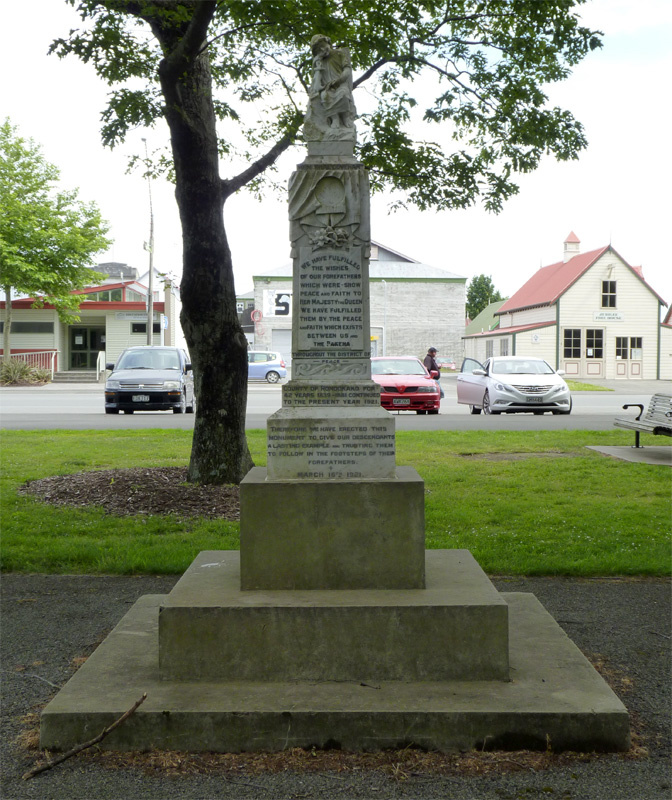
A memorial known as the 'Māori Peace Statue' or 'Māori Peace Monument' stands among the trees that line Dixon Street in Queen Elizabeth Park, Masterton. It is a marble column set on a stepped concrete base and surmounted by a carving of an angel. The inscription on the front reads:
MEMORIAL COVENANT // [carved panel] // WE HAVE FULFILLED / THE WISHES / OF OUR FOREFATHERS / WHICH WERE - SHOW / PEACE AND FAITH TO / HER MAJESTY THE QUEEN / WE HAVE FULFILLED / THEM BY THE PEACE / AND FAITH WHICH EXISTS / BETWEEN US AND / THE PAKEHA. / THROUGHOUT THE DISTRICT OF / - PEACE - / [carved panel] // COUNTY OF RONGOKAKO FOR / 42 YEARS 1839-1881 CONTINUED / TO THE PRESENT YEAR 1921. // THEREFORE WE HAVE ERECTED THIS / MONUMENT TO GIVE OUR DESCENDANTS / A LASTING EXAMPLE AND TRUSTING THEM / TO FOLLOW IN THE FOOTSTEPS OF THEIR / FOREFATHERS. / + / MARCH 16TH 1921.
The monument was unveiled in what was then known as Masterton Park on 4 December 1921. The inscription refers to the unbroken peace that had persisted between Māori and Pākehā in the Wairarapa since the introduction of Christianity to the region. Symbolically, the monument stood on the former site of the Masterton Stockade, which had been built in 1868 but had never seen military action. Equally symbolically, it was unveiled by a young Māori girl, Millie Te Tau and a young Pākehā girl, Alison Pragnell, the daughters respectively of the principal speakers at the unveiling ceremony: the Ngai Tumapuhiarangi chief Taiawhio Te Tau, chairman of the Rongokako Maori Council, and O.N.C. Pragnell, the mayor of Masterton.
The monument was the successor of a memorial stone that had been erected in Ngā Tau E Waru meeting house at Te Ore Ore marae after a hui held there in March 1861 to discuss the prophecies of the chief Pāora (Paul) Te Potangaroa. Te Potangaroa's prophecies were set down in a covenant that was placed under the memorial stone. On 16 March 1921, at another hui held at Te Ore Ore, it was decided to build a new memorial in Masterton.
Among the predictions Potangaroa had made was one concerning the coming of a special church for Māori. This distinction had been claimed by the Church of the Seven Rules of Jehovah, a church founded in the mid-1890s by Simon Patete, a Ngāti Kuia chief from Havelock, which had gained a wide following in the Wairarapa (in 1910 Taiawhio Te Tau had been appointed the church's bishop). Members of the church placed a new covenant inside the Masterton Park monument. The monument was opened and the covenant renewed in 1961 and again in 2001.
See: 'Local and general news', NZ Herald, 16/3/1921, p. 6; 'Local & general', Wairarapa Daily Times, 17/3/1921, p. 4; 'Maori and Pakeha: Peace Memorial: Ceremony at the Park', Wairarapa Daily Times, 5/12/1921, p. 6; Bronwyn Elsmore, Mana from Heaven: A Century of Maori Prophets in New Zealand, Auckland, 1999, pp. 246-55, 326-32 (photograph of the memorial stone at Te Ore Ore, p. 247); Gareth Winter, 'Wairarapa history ... peace statue' (article published on the Rangitane o Wairarapa Education website in 2015); the same source accesses a recent photograph of the peace monument).


Community contributions